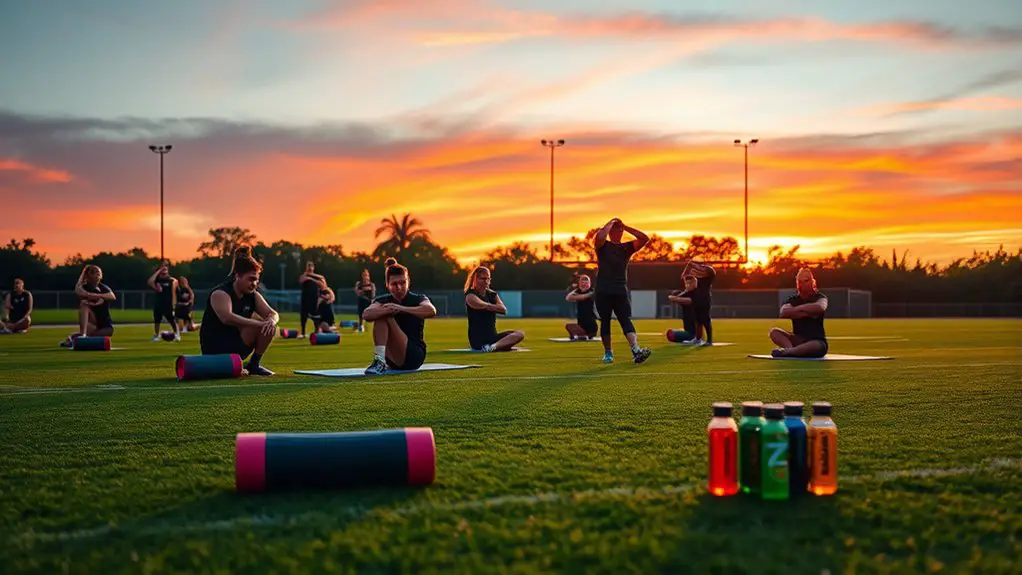To recover from a pulled muscle quickly, you need to recognize the signs like sharp pain and swelling. Rest is essential to let your muscle heal. Apply ice for 15-20 minutes every hour to reduce pain and swelling. Using a compression bandage and keeping the injured area elevated can also help. Gradually reintroduce activity, starting with light movements. By taking these steps, you'll be on your way to recovery, and there's more to discover about enhancing your healing journey.
Understand the Injury: Signs and Symptoms of a Pulled Muscle
When you pull a muscle, you might experience several distinct signs and symptoms that can help you identify the injury. You may feel sudden pain, often sharp, at the moment of the pull. This discomfort might be accompanied by swelling or tenderness in the affected area. You might also notice bruising, which can develop over time. Limited mobility is common, making it hard to move the muscle without pain. If you try to push through the discomfort, you could feel a nagging ache that lingers. It's important to listen to your body; recognizing these signs is the first step toward regaining your freedom of movement. Understanding your injury empowers you to make informed choices for your recovery journey.
Rest and Recovery: The Importance of Taking a Break
While it might be tempting to push through the pain, taking a break is essential for recovering from a pulled muscle. Your body needs time to heal, and rest is a vital part of that process. Ignoring the injury can lead to longer recovery times or more severe damage.
Here's a quick look at what rest can do for you:
| Benefits of Rest | How It Helps Your Recovery |
|---|---|
| Reduces Inflammation | Less strain on the injured muscle. |
| Prevents Further Injury | Allows healing without aggravation. |
| Enhances Blood Flow | Promotes nutrient delivery to tissue. |
| Boosts Recovery Speed | Shortens overall healing time. |
Ice Therapy: Reducing Swelling and Pain
Applying ice to a pulled muscle can greatly reduce swelling and pain, helping you feel more comfortable during recovery. Ice therapy is a simple, yet effective technique you can use to speed up the healing process. Here's how to make the most of it:
Ice therapy can effectively reduce swelling and pain from a pulled muscle, aiding your recovery process.
- Apply ice packs for 15-20 minutes every hour
- Wrap the ice in a cloth to protect your skin
- Use ice therapy within the first 48 hours after the injury
- Listen to your body; if it feels too cold, take a break
Compression and Elevation: Supporting the Healing Process
After using ice therapy to manage pain and swelling, the next steps in your recovery involve compression and elevation. Applying a compression bandage can help reduce swelling and provide support to the injured area. Make certain it's snug but not too tight—this'll guarantee proper blood flow while still offering the support you need.
Elevation is equally important. Keeping the injured muscle elevated above heart level can greatly decrease swelling and promote healing. You can prop it up with pillows while resting. These two methods work hand in hand to aid your recovery, letting you feel more in control of your healing process. Remember, taking these steps can help you get back to your active lifestyle sooner rather than later.
Gentle Stretching and Strengthening: Regaining Mobility
As you start to feel better, incorporating gentle stretching and strengthening exercises can be essential for regaining mobility. These exercises not only help increase flexibility but also support the recovery process. Remember to listen to your body and go at your own pace. Here are some activities to contemplate:
Incorporating gentle stretching and strengthening exercises is key to regaining mobility and supporting your recovery journey.
- Static stretches: Hold gentle stretches for 15-30 seconds to relax the muscle.
- Light resistance training: Use resistance bands or light weights to gradually build strength.
- Yoga or Pilates: These practices enhance flexibility and core stability without straining your muscles.
- Balance exercises: Simple movements can improve coordination and prevent future injuries.
Gradual Return to Activity: How to Ease Back Into Your Routine
While it's tempting to jump back into your regular activities, it's crucial to ease into your routine gradually to avoid re-injury. Start with light activities that don't strain your muscles, like walking or gentle cycling. Listen to your body; if something feels off, don't push it. Gradually increase the intensity and duration of your workouts, allowing your muscle to strengthen without overdoing it. Incorporate cross-training to keep things fresh and fun while minimizing stress on the injured area. Remember, taking your time now means more freedom later. Celebrate small victories to keep yourself motivated, and don't hesitate to seek guidance from a professional if you're unsure. Your body will thank you for being patient and mindful.
Frequently Asked Questions
How Long Does It Typically Take to Fully Heal a Pulled Muscle?
Typically, it takes about two to six weeks to fully heal a pulled muscle, depending on the severity. You'll want to listen to your body and avoid rushing back into activity too soon.
Can I Still Exercise While Recovering From a Pulled Muscle?
You can still exercise while recovering, but listen to your body. Light activities like walking or gentle stretching can promote healing. Just avoid anything that causes pain, and give yourself the freedom to rest when needed.
Is There a Risk of Re-Injuring the Muscle During Recovery?
About 50% of athletes experience re-injury during recovery. You'll want to ease back into activities gradually, listen to your body, and avoid pushing too hard, ensuring you maintain your freedom to move without pain.
What Over-The-Counter Medications Can Help With Pain Relief?
For pain relief, over-the-counter options like ibuprofen or acetaminophen can help. They'll reduce inflammation and discomfort, making it easier for you to move around. Just remember to follow the recommended dosages for safety.
Are There Specific Foods That Aid in Muscle Recovery?
Did you know that 20% of muscle recovery relies on nutrition? Incorporating foods rich in protein, omega-3s, and antioxidants can boost your healing. So, enjoy a balanced diet and give your body the freedom to recover!




